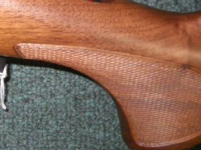" how do you sand the checkering areas without screwing up the checkering? "
Short answer - you CAN'T. The only thing you can do, if you must sand the stock, is either 1) mask off and AVOID the checkered areas......or 2) sand the whole stock, then RE-CUT the checkering. (Or, you COULD sand the stock down enough to eliminate the checkering - but I doubt you'd want to do that.)
The question is, do you really NEED to sand the stock ? If the surface is smooth as is, you may not really need to sand. If there are imperfections, then you might get away with light sanding to fix the imperfections (but only in those areas), carefully feathered into the rest of the surface.
If you are thinking that you MUST sand in order to remove the existing finish, that MAY well not be necessary. If the existing finish is poly, you probably do NOT need to remove it (and I wouldn't want to, if I were you). If the existing finish is an oil finish, or some type of varnish, etc., you still might be able to leave it alone, as long as you thoroughly de-grease the wood first. You need to de-grease anyway, so that is not a problem, in and of itself.
I have no direct personal experience with Duracoat, so IF the Duracoat people say that you MUST remove ANY old finish, regardless of condition or type, then you are sort of screwed, as regards the checkering.

